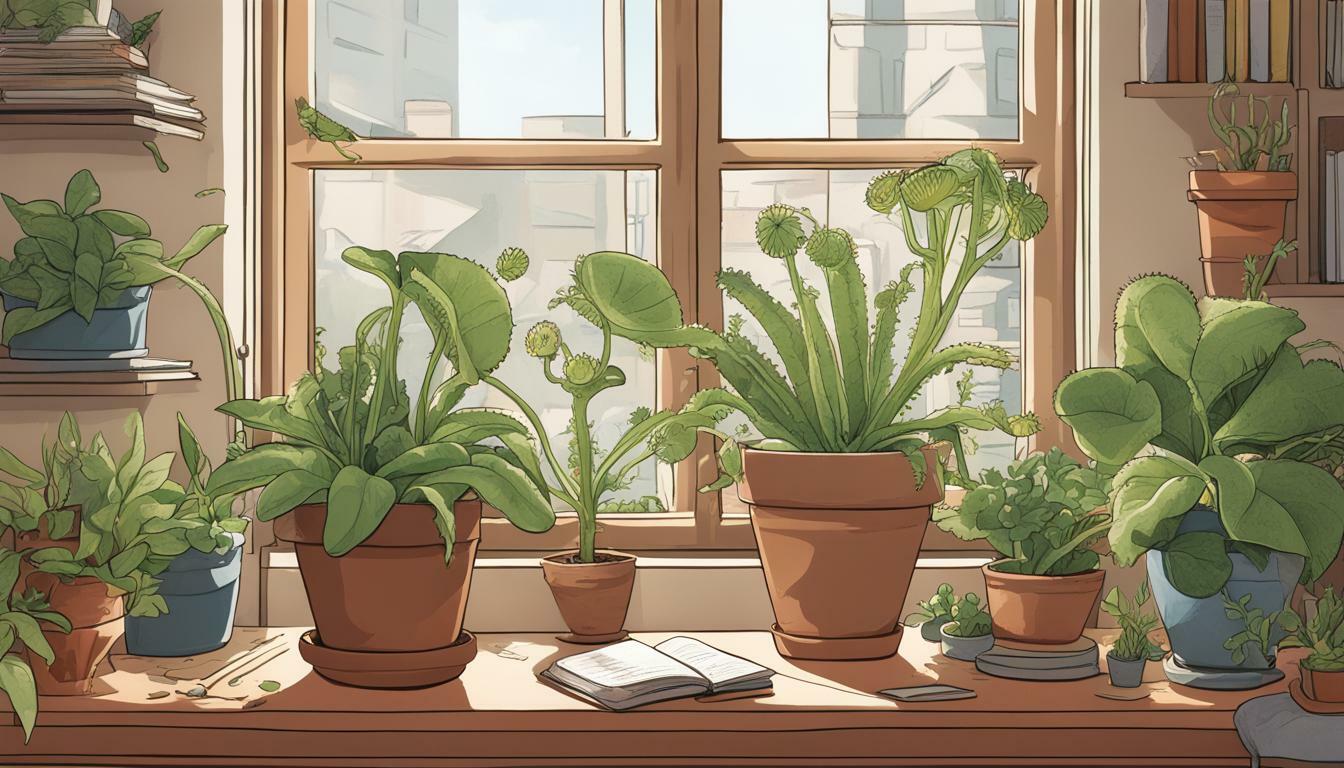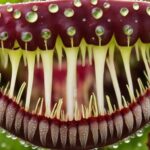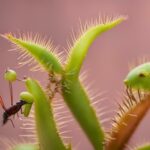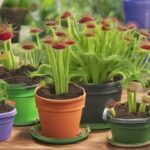A Venus flytrap is a fascinating plant with unique characteristics that make it a popular choice for indoor gardening enthusiasts. But can you keep a Venus flytrap in your bedroom? The short answer is yes, but there are some important factors to consider before you bring one home.
In this article, we’ll explore the feasibility of keeping a Venus flytrap in your bedroom, discuss the proper care and maintenance required for optimal growth, and highlight the potential benefits of having a Venus flytrap as a houseplant.
Key Takeaways
- It is possible to keep a Venus flytrap in your bedroom as an indoor plant.
- Venus flytrap care and maintenance are essential for its health and longevity.
- Growing a Venus flytrap indoors requires proper environment control, including temperature and humidity.
- A Venus flytrap can act as a natural air purifier, improving indoor air quality.
- Facts about Venus flytraps can help you better understand their unique characteristics and requirements.
- Creating the ideal environment for your Venus flytrap can help ensure its growth and survival.
Venus Flytrap Care and Maintenance
While Venus flytraps are fascinating and unique plants, it’s important to remember that they require specific care in order to thrive. By maintaining the right habitat conditions and providing regular maintenance, you can keep your Venus flytrap healthy and vibrant.
Venus Flytrap Care
When it comes to caring for a Venus flytrap, one of the most important things to keep in mind is watering. These plants need to stay consistently moist, but not over-watered. One effective way to water a Venus flytrap is to set the pot in a shallow tray of distilled or rainwater, making sure the water level stays below the surface of the soil.
Feeding is another crucial aspect of Venus flytrap care. These plants get their nutrients from consuming insects, so it’s important to provide them with this food source, especially during their active growing season. Feeding should be done sparingly, with only a few insects per month, to avoid stressing the plant.
Light is also important for Venus flytrap growth, with these plants needing at least four hours of direct sunlight every day. If growing indoors, you may need to consider supplemental lighting to provide the necessary amount of light.
Venus Flytrap Maintenance
Regular maintenance is necessary to keep Venus flytraps healthy and thriving. It’s important to remove any brown or dead leaves, as well as any traps that have turned black or stopped functioning. Traps that have captured insects should be left alone, as they provide the plant with necessary nutrients.
Humidity is also important for Venus flytrap health, with these plants preferring high humidity levels. Adding a humidity dome or setting the pot in a tray of water can help maintain the right moisture level.
Venus Flytrap Habitat
Venus flytraps are native to the wetlands of the southeastern United States, so it’s important to mimic this environment as closely as possible. This includes using a well-draining soil mix that is a blend of sphagnum peat moss and perlite, as well as a pot with drainage holes to prevent waterlogging.
Temperature is another important consideration, with Venus flytraps preferring daytime temperatures around 70-80°F and nighttime temperatures around 60°F. It’s important to avoid exposing these plants to extreme temperatures, as this can be harmful to their growth and overall health.
Growing a Venus Flytrap Indoors
If you’re looking to grow a Venus flytrap indoors, there are some unique challenges and considerations to keep in mind. Here are some indoor gardening tips for successfully growing a Venus flytrap in your bedroom:
- Temperature control: Venus flytraps thrive in warm temperatures, ideally between 70-85°F. You may need to invest in a heating pad or similar device to maintain the ideal temperature.
- Humidity: Venus flytraps require high humidity levels, ideally between 50-70%. Consider using a humidifier or placing a tray of water near the plant.
- Lighting: Venus flytraps require bright, indirect light. Consider placing the plant near a window that gets plenty of sunlight but avoid direct sunlight as it can burn the leaves.
- Soil: Use a well-draining soil mix made of peat moss, perlite, and sand. Avoid using regular potting soil as it can hold too much water and lead to root rot.
- Watering: Venus flytraps require moist but not waterlogged soil. Water the plant using distilled or rainwater as tap water can contain minerals that are harmful to the plant.
- Feeding: Venus flytraps are carnivorous plants and require a diet of insects to thrive. However, avoid feeding the plant too often as it can exhaust the plant’s energy and lead to death.
By following these indoor gardening tips, you can create the optimal growing conditions for your Venus flytrap and enjoy the unique beauty of this fascinating plant in your bedroom.
Benefits of Keeping a Venus Flytrap as a Houseplant
If you’re looking for a unique and natural way to enhance your bedroom’s aesthetic appeal, look no further than a Venus flytrap. But did you know that it can also act as a natural air purifier, removing toxins and improving indoor air quality? Keeping a Venus flytrap in your bedroom offers several benefits, including:
- Improving indoor air quality by removing pollutants and toxins
- Adding a unique and captivating element to your bedroom’s decor
- Providing a natural conversation starter for guests
However, in order to fully enjoy the benefits of a Venus flytrap as a houseplant, it’s important to provide suitable conditions for its growth and health.
The ideal habitat conditions for a Venus flytrap include a mix of bright, indirect light and shade, high humidity levels, and moist soil that is free of minerals and other contaminants. In addition, it’s important to avoid over-watering and to maintain a consistent temperature range of 70 to 85 degrees Fahrenheit.
By following proper care and maintenance guidelines, you can ensure that your Venus flytrap thrives as a houseplant, providing not only a unique decorative element but also air-purifying benefits for your bedroom.
Facts about Venus Flytraps
If you’re considering growing a Venus flytrap in your bedroom, it’s important to learn more about these fascinating plants. Here are some interesting facts and FAQs:
Venus Flytrap Facts
- The Venus flytrap is native to the wetlands of North and South Carolina in the United States.
- The scientific name for the Venus flytrap is “Dionaea muscipula.”
- Venus flytraps are carnivorous plants, meaning they obtain nutrients by trapping and digesting insects.
- Venus flytraps have special “trigger hairs” that cause the plant to close its leaves when insects land on them.
- The leaves of a Venus flytrap can only close a certain number of times before they die and fall off, so be careful not to overfeed your plant!
Venus Flytrap FAQ
- How long do Venus flytraps live? Venus flytraps can live up to 20 years with proper care.
- Do Venus flytraps need to be fed? Yes, Venus flytraps need to be fed insects to obtain nutrients, but be careful not to overfeed them.
- Can Venus flytraps survive indoors? Yes, Venus flytraps can survive indoors if they are provided with proper care and growing conditions.
- Are Venus flytraps dangerous to humans? No, Venus flytraps are not dangerous to humans and their “teeth” only serve to keep insects trapped inside.
- How do Venus flytraps reproduce? Venus flytraps can reproduce through seeds or by dividing the plant into smaller sections.
Now that you’ve learned more about Venus flytraps, you can impress your friends with your knowledge and take better care of your own plant. Remember, providing suitable conditions for Venus Flytraps to grow is key to their survival and longevity in your bedroom.
Creating the ideal environment for your Venus flytrap
While Venus flytraps can grow in a variety of conditions, creating the ideal environment can make all the difference in the plant’s health and longevity. Here are some tips for growing a Venus flytrap indoors:
Select the right pot
Choose a pot with good drainage to ensure your Venus flytrap is not sitting in water for too long. A plastic or terra cotta pot is ideal, with a diameter of at least 4 inches. Avoid deep containers to prevent water from accumulating at the bottom.
Use the right soil
Venus flytraps require well-draining soil that is low in nutrients. A mix of sphagnum moss and sand or perlite is ideal, as it mimics the plant’s natural growing conditions. Avoid using regular potting soil, as it can be too rich for Venus flytraps.
Provide the right lighting
Venus flytraps require bright, direct sunlight for at least 4-6 hours per day. A south or east-facing window is the best spot for them. If you don’t have access to enough natural light, consider using artificial grow lights to supplement.
Maintain the right temperature
Venus flytraps do best in temperatures between 70-85°F during the day and 55-65°F at night. Keep them away from cold drafts or hot radiators, which can harm the plant.
Keep humidity levels high
Venus flytraps grow naturally in humid environments, so it’s important to maintain high levels of humidity when growing them indoors. This can be achieved by placing a tray filled with pebbles and water beneath the pot or using a humidifier.
By following these tips and creating the ideal environment, your Venus flytrap is sure to thrive indoors!
Growing a Venus Flytrap Indoors: Tips for Indoor Gardening
If you’re interested in adding a unique and fascinating plant to your indoor garden, a Venus flytrap could be the perfect choice. Growing Venus flytraps indoors requires a bit of extra attention, but with proper care and maintenance, you can enjoy this carnivorous plant in your bedroom or other indoor spaces. Here are some indoor gardening tips to help you get started:
Creating the Ideal Environment for Your Venus Flytrap
Venus flytraps are native to the coastal bogs of the Carolinas, so it’s important to mimic their natural environment as closely as possible. This means using a soil mix that is free of nutrients and minerals, such as a mixture of peat moss and perlite or sand. It’s also important to choose a pot that is appropriately sized for your plant, with drainage holes to prevent water from accumulating in the soil. Finally, make sure your Venus flytrap gets plenty of bright, indirect sunlight, ideally through a south-facing window.
Maintaining Proper Care for Your Venus Flytrap
Venus flytraps require a bit more attention than other houseplants, but the effort is well worth it. These plants thrive in a consistently moist environment, so make sure to keep the soil moist at all times. Avoid tap water or any other source of water with minerals, as this can harm your plant. Instead, use distilled or rainwater to keep your Venus flytrap hydrated. You can also feed your plant live insects, such as fruit flies, every few weeks to supplement its diet.
The Benefits of Keeping a Venus Flytrap in Your Bedroom
Not only are Venus flytraps fascinating plants to keep in your bedroom, they can also help to improve the air quality. These plants act as natural air purifiers, removing toxins and pollutants from the air. Additionally, the unique appearance and behaviors of Venus flytraps can make for an interesting and attractive addition to any indoor garden.
With these indoor gardening tips, you can create the ideal environment for your Venus flytrap to thrive. From proper soil and pot selection to feeding and watering requirements, taking care of this carnivorous plant can be a rewarding and fascinating experience.
Is It Normal for a Venus Flytrap to Turn Black After Eating?
Is it normal for a Venus Flytrap to turn black after eating? Yes, the phenomenon of a venus flytrap turning black after eating is a natural and expected occurrence. This change in color indicates that the plant has successfully captured and digested its prey, as the darkening is a result of digestive enzymes breaking down the captured insect.
FAQ
Q: Can you keep a Venus flytrap in your bedroom?
A: Yes, you can keep a Venus flytrap in your bedroom. However, it is important to understand the care and growth conditions required for this unique plant.
Q: What are the care and maintenance requirements for a Venus flytrap?
A: Venus flytraps require proper watering, feeding, and light conditions. It is crucial to understand their habitat requirements and provide the necessary care for their health and longevity.
Q: What are some tips for growing a Venus flytrap indoors?
A: Growing a Venus flytrap indoors comes with its own challenges. Consider temperature and humidity control and create the right environment within your bedroom. It is important to provide suitable conditions for their growth.
Q: What are the benefits of keeping a Venus flytrap in your bedroom?
A: Keeping a Venus flytrap in your bedroom has several advantages. It acts as a natural air purifier, enhancing indoor air quality. Additionally, the unique appearance and captivating behavior of Venus flytraps can enhance the aesthetic appeal of your bedroom.
Q: What are some interesting facts about Venus flytraps?
A: Venus flytraps are fascinating plants. They have intriguing characteristics, a carnivorous nature, and a specific habitat in the wild. Learn more about their growth, lifespan, and unique attributes.
Q: How can you create the ideal environment for your Venus flytrap?
A: Creating the optimal environment for your Venus flytrap involves proper soil, pot selection, and drainage. Mimicking the plant’s natural habitat will ensure its thriving growth indoors.











